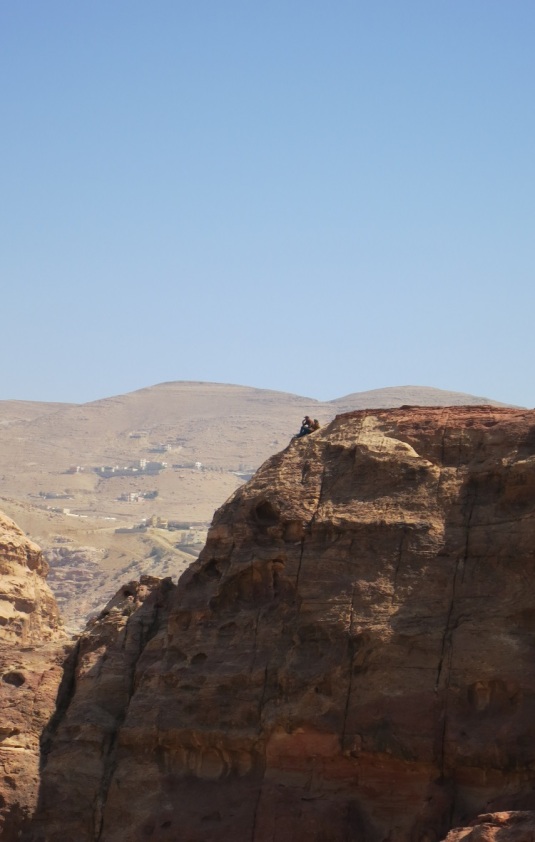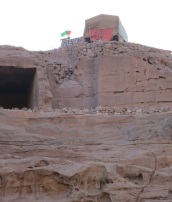
Our final destination was Jabreen Castle.

Afraid he was not going to get a tip, Zaher led us through the castle pointing out the signs on the walls. The renovated fort/palace/university was built in the 15th century.

Throughout the castle, the rectangular rooms were similar with low windows that opened near the floor and high ceilings that vented outside, naturally cooling the rooms.

The beautiful, recently painted ceilings looked like carpets. We wove through the maze of rooms.
Hoping we didn’t want to go up, our guide weakly pointed to the upper floors and said “the rooms look the same upstairs.”

“Let’s go,” I said, “you’ll get your exercise.”
The interiors were similar but the views were great. Eventually we made our way to the highest rooftop that overlooked the valley. A French TV camera was taking pictures of the Omani flag waving in the wind.

We took the same photo and chatted with the tourists.
An Omani man was lecturing his maid (seen in the first picture at the castle door), his wife holding a newborn and his five children under the age of seven on the palace architecture. When he saw Goldie and I walk through the doorway, his eyes lit up. He left his family and made a bee-line to us. We were the audience he was looking for. Before we could say salam, he began telling us about the architecture. Unable to add to the conversation, Zaher sat on the side strumming his fingers.

After a half an hour of his time, we thanked him and he thanked us. We moved on trying to take artistic photos that might make us famous.
As we left Zaher asked if we needed the ladies room before our hour and a half drive back to Muscat.

We decided to take advantage and were pleased we did. The restrooms at Jabreen Castle were new, modern and clean. We told Zaher,
“From now on don’t bother with the hammam in Bahla. Just bring your clients to the Jabreen Castle.”
We started our drive back to Muscat.
I asked, “What is the difference between the Ibadiyyah and the Sunni and Shiite.”
“There is no difference really. We are all Muslims.”
“But there must be something different otherwise you would be Sunni.”
“It is mostly how we pray. We pray like this,” he said taking his hands off the steering wheel, putting his hands together and not moving. “And they pray like this,” he said moving his hands from chest down to his thighs. “See little difference, we are all Muslims.”
It didn’t seem like enough difference to make a distinction between the sects.
Zaher said “I am not a good Muslim” and admitted he did not know what the deeper differences were.
At home after doing some research I understood Zaher’s description better.
There is a fundamental difference in how the Ibadi pray – standing up. There are also some particular doctrinal differences with the Sunni around how Imams are chosen and what happens to fallen Muslims. Ibadi rejected the Qunut prayer which says:
O’ Allah ! I seek help from You, ask forgiveness from You, and believe in You and praise You for all the good things and are grateful to You and we part and break off with all those who disobedient to You. O Allah, You alone do we worship and pray exclusively to You and bow before You alone and we hasten eagerly towards You and fear Your severe punishment and hope for Your mercy, for Your severe punishment is surely to be meted out to the disbelievers.
My understanding is Ibadi rejected this prayer because it said “we part and break off with all those who (are) disobedient to you” and “Your severe punishment is surely to be meted out to the disbelievers.”
Ibadiyyah practice barā’ah: dissociation (but not hostility) towards unbelievers,sinners, and those destined for Hell. They believe in wuqūf: reservation towards those whose status is unclear. This view allows for them to have quiet interaction with others, but not in a way that causes strife or disagreement. This underlying belief probably explains some of Zaher’s casual “Maybe this or maybe that” attitude.
Zaher admitted he had never even traveled to any other Gulf country so he really didn’t know any Muslims besides the Ibadiyyah. Like his forefathers, Zaher was isolated – and protected – from the other Gulf countries by the Hajar mountains.
We rode in silence observing the countryside. There were quite a few newer, two and three story villas near the road.
Zaher pointed out, “these villages are further away, but these houses are moved out.”
I finally understood what he was saying. The small villages were expanding and we were seeing the new houses being built on the outer circumference.
“What is the population of Muscat today,” I asked thinking about the new roads and houses that seemed to be popping up around the countryside.
“5 million”
“5 million?” That sounded very high. I pulled out our guide book.
“Wow,” I said. “This guidebook was written in 2003. There were 2.3 million then. In less than ten years the population has doubled. That is amazing. Why are so many people coming to Oman?” I asked.
“Some people they come and some people they go,” he said in his non-committal way.
Later when I checked out Oman’s population, the World Bank’s estimate was 2.78 million in 2010.
Ding, ding, ding.








































